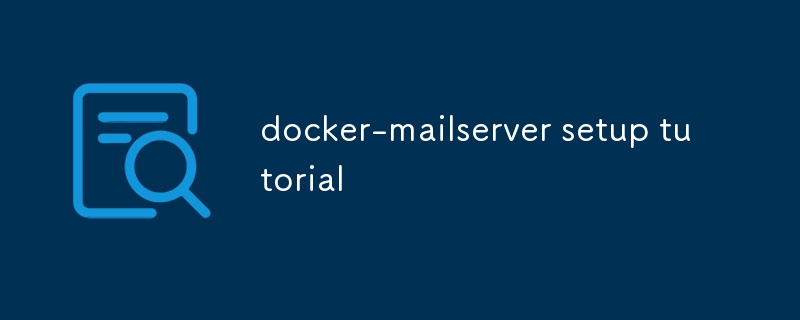docker-mailserver搭建教程
- DDD原创
- 2024-08-15 14:34:19883浏览
本文提供了使用自定义域设置和保护 Docker 邮件服务器的全面指南。它解决了密码安全、TLS/SSL 加密、速率限制和双因素身份验证等挑战。本文还

如何为 Docker 邮件服务器创建自定义域
- 使用邮件服务器镜像启动一个新容器。例如:
docker run -d --name mailserver mailserver/postfix。docker run -d --name mailserver mailserver/postfix. - Open a terminal session inside the container:
docker exec -it mailserver bash. - Edit the postfix configuration file:
nano /etc/postfix/main.cf. -
Update the "myhostname" and "mydomain" variables with your desired values:
myhostname = your-hostname.example.commydomain = example.com
- Save and exit the configuration file.
- Run the command:
service postfix restartto apply changes. - Edit the hosts file on your local machine:
sudo nano /etc/hosts. - Add a new line with the following format:
your-ip-address your-hostname.example.com. - Save and exit the hosts file.
- Now, your custom domain should be set up for the mailserver.
What Security Measures Should I Implement for My Docker Mailserver?
- Use strong passwords: Make sure to set strong and unique passwords for your mailserver account and database.
- Enable TLS/SSL: Encrypt communication using TLS/SSL certificates to protect against eavesdropping and data interception.
- Implement rate limiting: Use rate limiting to control the number of emails that can be sent from your mailserver within a specific time interval. This can help prevent spam and abuse.
- Enable two-factor authentication (2FA): Add an extra layer of security by requiring users to provide a second form of authentication, such as a code sent to their phone, when logging in.
- Keep software up-to-date: Regularly update your mailserver software and operating system to patch security vulnerabilities.
How Can I Troubleshoot Common Issues with My Docker Mailserver Setup?
-
Check the logs: Check the mailserver logs, typically found in
/var/log在容器内打开终端会话: - 编辑后缀配置文件:
nano /etc/postfix/main.cf。 - 用您想要的值更新“myhostname”和“mydomain”变量:
mydomain = example.com- 保存并退出配置文件。 运行命令:
docker exec -it mailserver bash。myhostname = your-hostname。 example.comservice postfix restart应用更改。sudo nano /etc/hosts。🎜🎜添加具有以下格式的新行:your-ip-address your-hostname。 example.com.🎜🎜保存并退出主机文件。🎜🎜现在,应该为邮件服务器设置您的自定义域。🎜🎜🎜我应该为我的 Docker 邮件服务器实施哪些安全措施?🎜🎜🎜🎜使用强密码:🎜 确保为您的邮件服务器帐户和数据库设置强且唯一的密码。🎜🎜🎜启用 TLS/SSL:🎜 使用 TLS/SSL 证书加密通信以防止窃听和数据拦截。🎜🎜🎜实施速率限制:🎜 使用速率限制来控制在特定时间间隔内可以从邮件服务器发送的电子邮件数量。这可以帮助防止垃圾邮件和滥用。🎜🎜🎜启用双因素身份验证 (2FA):🎜 通过要求用户在登录时提供第二种形式的身份验证(例如发送到手机的代码)来添加额外的安全层.🎜🎜🎜保持软件最新:🎜定期更新您的邮件服务器软件和操作系统以修补安全漏洞。🎜🎜🎜如何解决 Docker 邮件服务器设置的常见问题?🎜🎜🎜🎜检查日志:🎜检查邮件服务器日志(通常位于 /var/log 中)是否有任何可能有助于识别问题的错误消息。🎜🎜🎜验证 DNS 设置:🎜 确保已配置自定义域的 DNS 记录正确并指向您的邮件服务器的 IP 地址。🎜🎜🎜重新启动邮件服务器:🎜 有时,重新启动邮件服务器服务可以解决临时问题。🎜🎜🎜检查防火墙设置:🎜 确保主机上的防火墙允许连接到邮件服务器的端口(通常为 25、110、143、587 和 993)。🎜🎜🎜尝试使用其他电子邮件客户端:🎜如果您在发送或接收电子邮件时遇到问题,请尝试使用其他电子邮件客户端以排除任何客户端问题问题.🎜🎜以上是docker-mailserver搭建教程的详细内容。更多信息请关注PHP中文网其他相关文章!
声明:
本文内容由网友自发贡献,版权归原作者所有,本站不承担相应法律责任。如您发现有涉嫌抄袭侵权的内容,请联系admin@php.cn
上一篇:docker compose教程下一篇:docker 安装教程

